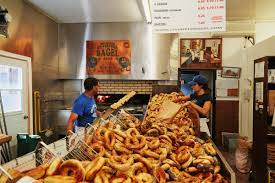
If you grew up, as I did, in a city that is known for its bagels, you will no doubt know that the bagels you ate were the best and nobody could ever convince you that theirs’ were better. Not a chance! So, now that I have made this very clear, I grew up in Montreal, and Montreal has the best bagels, period. However, it is a bit more complex than this.
I am certain that my first introduction to these delicious, irregular-shaped carbs was as a young boy, but my first recollection of bagels came when as a family we moved to a suburb of Montreal (Ville St. Laurent) when I was twelve. A short walk from my new home was a small strip mall that had a bakery called Cantors, which is where my bagel love affair began. (The photo above was a poster in their front window for as long as I can remember). It was only a year or two later that I discovered that the bagels Cantors sold actually came from a bagel factory in the Mount-Royal area of Montreal, called St. Viateur Bagels located, conveniently enough, on St. Viateur street. And here is where the complexity kicks in. Montreal has another famous bagel factory, in the same area of Montreal called Fairmount Bagel, which can lay claim to being the first bagel factory of its kind in Montreal. It was opened in 1919 by a Russian, Jewish immigrant. It was originally called the Montreal Bagel Bakery and was located on St. Laurent Boulevard. (That’s twice with the same name, which is St. Lawrence for Anglos!), however in 1949, Grandfather Isadore (as he was called by then) relocated to a cottage on…you guessed it, Fairmount Avenue, where it is still thriving (even though most of the people I know, gave up carbs years ago!). Now, by comparison, my favorite bagel place as I have already mentioned, is actually the upstart in this “war,” as it was opened in 1957 by a Polish Holocaust survivor eight years after Montreal Bagel had relocated!
There have always been and still are comparisons between New York Bagels and Montreal bagels (Montreal’s are better!), but these battles pale in comparison to the all out war between Fairmount and St. Viateur bagel eaters. I mean you would need to create another DEFCON stage to properly represent the animosity between these two enemies. Okay, you might be able to accuse me of a little too much hyperbole here, but you most likely weren’t there at that time, and if you were, then you know exactly what I’m talking about!
I relocated in 1983 to Vancouver, British Columbia, and had to leave my beloved bagels behind. You can imagine my excitement when I saw an advertisement for a store called Montreal Bagel. I dropped what I was doing and drove down there straight away, only to walk into the shop to see a wall full of huge rolls that had holes in the center! What was even worse, they had cinnamon raisin bagels and sun dried tomato bagels; where I’m from, and where MY bagels are from, there were simply two kinds and only two kinds: Sesame seed, and poppy seed. Period. I wanted to hurl. (St. Viateur Bagels, of course, succumbed to popular demand and now make bagels in many of those “other” flavors to cater to those that…let’s just leave it there!). The poor young woman behind the counter could see the horror on my face, and cautiously asked me: “Ah, can I help you?” All I could muster in response was: “Where are your Montreal bagels?” She simply turned and pointed to the wall, which is when I left, but not before saying: “You’ve obviously have never been to Montreal!” Poor kid. I felt bad later, but I felt worse about not getting a Montreal bagel.
So, what’s the big deal about Montreal bagels, and in particular MY bagels you might ask? It’s how they are made. And while many attempts have been made by others to replicate this process of making bagels, only a few have come close, and many have not. I could not even begin to tell you how Fairmount makes theirs, but at St. Viateur, at that time, the dough was kneaded by hand, then rolled by hand, and dropped into boiling honey water, topped with either poppy or sesame seeds, before they were loaded onto long wooden planks and gently placed on a large brick oven floor with a wood fire raging beside it.


Why is the process important you may ask? Because it is 100% the process that gives St. Viateur bagels their unique taste, shape, and consistency. To be honest, they are not to everyone’s liking, but for me they are the only ones I truly like, and I have had my share of other kinds. Even in Los Angeles, where I now live, a food mecca if there ever was one, the bagels, I am sorry to say, pale in comparison. I fully expect to get flack for this…Bring it on! There is one danger associated with these bagels though, which is directly related to the increased visits to emergency rooms, especially on Sunday mornings, the unofficial bagel eating day, and that is they are very tricky to slice, and if you’ve been out partying the night before…well, let’s just say you’d better make sure your health insurance is in order! Of course, we live in an age of unbridled gadgetry, and perhaps because of the above, someone came up with this:

The handy bagel slicer. It works best on the kind of bagels that aren’t really bagels, but it does cut down on the hospital visits. If you have ever used one, you will know what I mean, but it also means that we can no longer be friends. Such is the price of being a purist!
I am sure some of you are rather skeptical at this point because all I have really given you are some facts about bagels and my very biased opinion about the ones that I prefer, but with very little to back up why and how I would know all this. Fair enough. For the record, I spent two summers in 1987 and 1989 working in a bakery on the west coast of Vancouver Island. Two nights a week, I worked the graveyard shift from midnight to around 6AM making about 300 loaves of bread in a shift as well as cinnamon and cheese buns. Except for the mixing of dry and wet ingredients, I did everything else by hand. Back in Vancouver after the summer of 1989, I worked part time for about two more years baking bread at a slightly more commercial operation that was part of the local co-op where I lived. While we did do some hand work on certain breads, the bulk of the product was all done by machine. Let’s just say, there is a difference! I still bake bread on occasion, but my skills are a bit rusty, at least when it comes to appearance, as you can tell from the photo below of the raisin bread I made last week. Not what you would call a normal shaped loaf, but it sure tasted good!

Los Angeles 2022

So there’s a reason the guy in the picture is missing a front tooth? Is it the price of authenticity? Nice repurposing of the guillotine — for those convicted of crimes against bagels. Growing up in Montreal must have be quite wonderful, a real place! xoxo
>
LikeLiked by 1 person
Haha! Yes there is. Isn’t it. I can picture the conversation: “What are you doing?” “Oh, just going to guillotine some bagels!” It was a pretty awesome city to grow up in!
LikeLiked by 1 person
Clearly, I have never tasted a real bagel 😥
LikeLiked by 1 person
Clearly!
LikeLike
Yes I remember the bagels in Montreal when I worked there in 1994. One of them was enough for breakfast. Here in Kelowna we have the Mount Royal Bagel Factory. The bagels were good until it was taken over by some middle eastern family.
The photos in my separate email show our efforts straight out of the oven this morning. These loafs are cut up into 3/4″ pieces and used as dunkers with tea or coffee. My (and now our) love for a dunker in bed with coffee while doing the daily crossword. If you love it, make it yourself.
LikeLiked by 1 person
Sounds good, I will have to try them. Thanks!
LikeLike
That’s a great bagel slicer, we have one too.
LikeLiked by 1 person